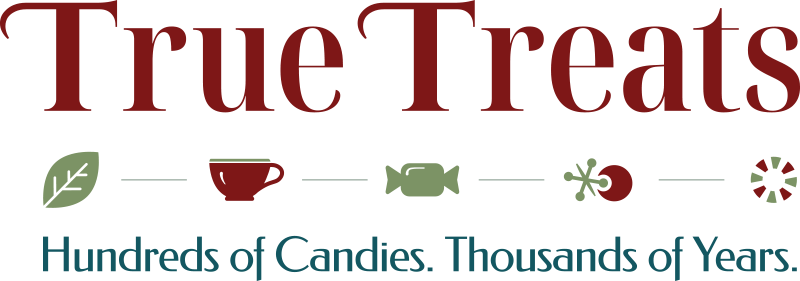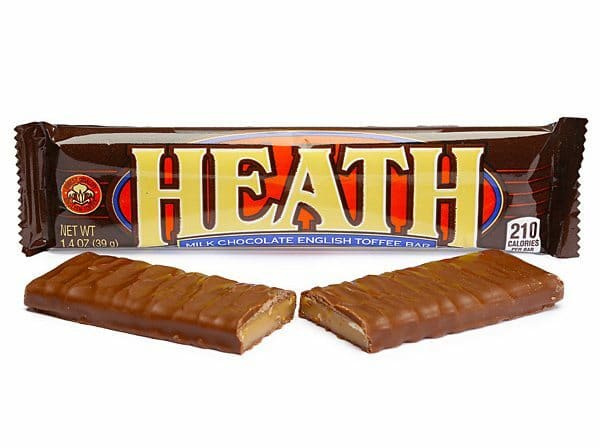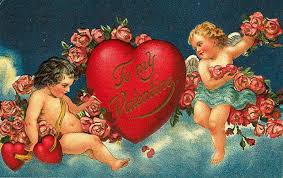What is the Heath Bar?
The heath bar is a deliciously thin, even candy bar, consisting of a thin layer of toffee wrapped in a smooth layer of milk chocolate. It’s the perfect combination of soft, smooth and crunch. Born in the U.S., the Heath Bar remains one of the nation’s great candy bars…all thanks to the doings of a schoolteacher and his two sons.
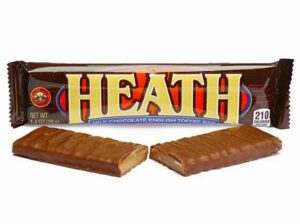
Heath Bar Today
Toffy, the Candy Bar, and the Birth of the Heath Bar
To understand the Heath Bar, it’s important to understand the candy bar. Now a favorite candy of American men today – the candy bar created by the Frye family of England in 1847. Most likely their candy bars were gritty as a means of creating the smooth chocolate didn’t exist yet. That changed in 1879 when Rodolphe Lindt invented a process known as “conching” to create the smooth, delectable texture of the chocolate we love so much today. CHOCOLATE BARS – In Order of Creation: Dark, Chocolate w/Almonds, Milk, White:
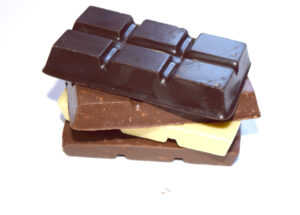
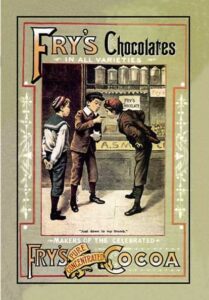
Heath Bar, Hershey Bar, Peanut Chew: The Candy Bar Difference
Candy bars were different from other chocolates. Most chocolates, indeed, most vintage candy, was weighed and sold by the pound. Candy bars, including the Heath Bar, Hershey Bar, and others, were called “count line’ candies, sold by the piece, typically wrapped and ready to go. Around 1912, a new invention appeared on the candy scene called “combination candy bars,” a chocolate candy bar filled caramel, peanuts, marshmallow, and, yes, toffee: all relatively new, post-Civil War ingredients the consumer loved. One of the first was the Goo Goo Cluster, made in Nashville and still around today:

These new candy bars gave confectioners the opportunity to fill their expensive chocolate with deliciously cheaper fillers, meaning they were more profitable. Even better, the count line aspect of candy bars, made them portable enough to withstand long trips to places such as the trenches in World War I, where they appeared in the first rations ever. These included the Clark Bar and Goldenberg’s Peanut Chew.
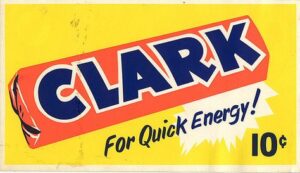
The Heath Bar, which was invented in 1928, eventually made an appearance in the supplies of fighters during World War II.
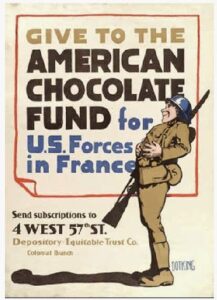
World War II Ad
Enter Milk Chocolate, Toffee & A New American Classic: The Heath Bar
In 1914, just as candy bars were making a mark in the chocolate kingdom, L.S. Heath, a schoolteacher in Illinois, was looking for a line of work for his two oldest sons Bayard and Everett. The reason? Were they ne’er-do-wells? Youngsters just starting out? History doesn’t tell. Luckily, L.S. Heath found a small confectionery for sale. He bought the shop and soon his sons were selling ice cream, fountain drinks, and sweets.
One thing led to another, and candy salesmen were hanging around the Heath brothers’ store, talking, as they do, about candy. One of them was raving about another candy-maker’s toffee, called “Trail Toffee.” Legend has it the salesmen offered to provide the Heath brothers with the recipe…and the next thing you know, it’s 1928 and the company is making what was known as “Heath English Toffee” or, simply “Heath Toffee.” The Heath Brothers tweaked the recipe and soon marketed it as “America’s Finest.” People traveled from all over the place to get some.
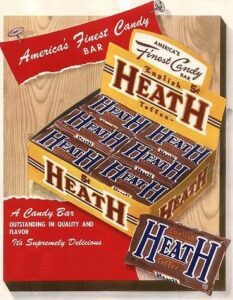
What is the Difference Between Toffee, English Toffee, and… Buttercrunch?
The difference between English toffee and plain old toffee isn’t entirely clear. Some say English toffee, made by the British, is made with more butter, and tends to be softer than the American version. In fact, some British toffee is closer to American taffy than, well, toffee. Then, there’s the explanation that nuts are the decisive factor. American toffee has nuts and British toffee doesn’t. If it has nuts on top, it’s actually buttercrunch. If it has nuts in it, it’s American toffee which is actually peanut brittle. Got it?
Never mind – stick with this: When the Heaths started selling their Heath Bar, they described it as “Heath Milk Chocolate English Toffee Bar.”
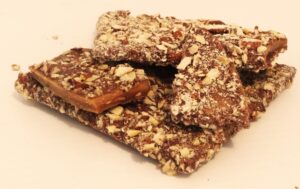
True Treats’ Buttercrunch
LOOK: Here’s a toffee comparison from The Nibble: The Nibble: Buttercrunch Toffee Difference
The Heath Bar Marketing Dilemma
In 1915, as the candy business was taking off, L.S. Heath bought a dairy. All went well, and in 1931, L.S. quit his job teaching school after twenty years. He then convinced his sons to sell the candy store and join the dairy business. They did, bringing at least some of the candy-making machinery with them.
It was the younger generation who also thought up this great marketing idea: why not sell our candies through the dairymen who went house-to-house selling milk, ice, and cheese. Just add “Heath Toffee” to the list and customers will add it to their purchases along with other products. And, of course, they did.
The Heath family also confronted a dilemma common to just about any manufacturer of any candy. How to distinguish themselves from the other toffee/English toffee/taffy/buttercrunch/brittle makers. They knew a good logo was at hand. So, they designed logo which had a large “H” at either end, with the “eat” in lower caps in the middle: HeatH.
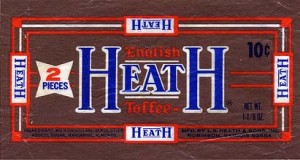
Now, here were the marketing dilemmas: First, the bar was one ounce, while the others were four, which convinced consumers they were buying a penny candy and not a five-cent bar which was typical of candy-makers of the time. Second, shoppers thought the name of the company was H&H with the “eat” telling them what to do with it. A third problem: the packaging, name aside, made it look like the laxative Ex-Lax. Salesmen weren’t sure what they were supposed to sell.
Reasons unknown, the Heath Bar took off anyway and is made by Hershey Today.
